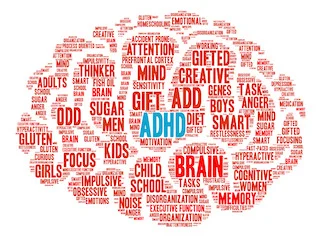Monday, October 7th, 2019
welcome to the leADDership brief
A weekly newsletter for creative and innovative people, like you, with ADHD who want timely, helpful, and interesting resources
for leading and living well with ADHD.
ADHD
Is NOT a Character Defect
Living Well With ADHD
During my 17 years as pastor on staff at a large church I created and led recovery programs, writing the curriculum for our largest and most successful program called Healing Journey: Equipping You To Heal, Grow, and Thrive. The program was based around the 12 Steps originated by Dr. Bob S. and Bill W., the founders of AA.
According to the Hazelden Betty Ford Foundation Steps 4, 5, 6, and 7 are as follows:
Step 4: Made a searching and fearless moral inventory of ourselves.
Step 5: Admitted to God, to ourselves, and to another human being the exact nature of our wrongs.
Step 6: Were entirely ready to have God remove all these defects of character.
Step 7: Humbly asked Him to remove our shortcomings.
I led Healing Journey groups three times a year for most of my 17 years on staff, and every session my lack of time management, impulse control, and organization would go on my moral inventory list among other things. I would go on to confess to God, myself, and my accountability partner how these defects were problematic, were contributing to my “larger issues,” and causing a lot of pain and frustration for me, my family, friends, and colleagues. I would go on to ask God to remove these shortcomings and character defects from my life.
And each new session of Healing Journey I would put them back on the list with a great sense of shame and defeat because it seemed like A) God wasn’t seeing fit to remove these “shortcomings and character defects” and B) I was STILL not managing my time or spaces well and I was forever “cleaning up” my impulsive words, acts, and decisions.
As an achiever this just felt like defeat and failure three times a year. It was exhausting.
But I was convinced my lack of time management, organization, and impulsivity were character defects I could fix if I just worked harder and tried harder. Or God could miraculously “fix me” if He saw fit. Which He didn’t seem to be doing.
Getting a diagnosis of ADHD, type anxious and over-focused, was a gift. I now had a name to give what I’d struggled with my entire life. I had a reason for running my life the way I did. I had an explanation for my way of being in my head.
I wasn’t defective, irresponsible, disrespectful, immature, or morally failing. I had a neuro-a-typical brain that was desperately trying to adapt to and function within a neuro-typical world according to “normal” executive functioning standards. (Who decides those anyway?)
It was never going to happen.
I’ve heard similar stories from my clients. We spend enormous amounts of time beating ourselves up for our perceived failings and defects. We don’t need others to be hard on us, we are out there waaaaayyyy ahead of you beating ourselves up and looking for the magic tool, resource, app, program, pill, etc. that will make us on time, focused, ahead of the curve, organized, motivated, and calm.
Don’t get me wrong, I love a good tool, program, or resource and I recommend many of them in this newsletter. However, there is no magic anything. There is accepting who we are, how our brains are wired, and what we do best so that we can leverage them to our advantage. It often means tweaking and massaging great tools meant for neuro-typical executive function brains for our neuro-a-typical brains.
And that takes a lot of creativity and innovation on our part!
This is why I am such a strong advocate for self-compassion and empathy when it comes to ADHD and how we function in our respective worlds. Self-compassion and empathy provide the space that we need to embrace new and helpful ideas, opportunities, and possibilities.
All that to say, I thought it might be helpful to share some information on what ADHD is and the accompanying symptoms.
Let’s redefine the cultural stigma that is an ADHD diagnosis and embrace the beauty and strengths that is you as an adult with ADHD.
In this week’s edition of the leADDership brief I define ADHD and its sub types. In the following weeks I’ll break down the symptoms and highlight the strengths of ADHD and how to live well and thrive as an adult with ADHD.
What is ADHD?
The meaning of ADHD is complex. It’s a misunderstood neurological condition that impacts the way our executive function, the part of our brain that help us plan, focus on, and execute tasks, works.
Symptoms vary significantly for each type, from bouncing-off-the-walls energy, to quiet spaciness and profound disorganization. And the severity of the symptoms vary from person to person.
ADHD is not caused by a bad childhood, too much sugar, too many video games, or a lack of discipline. ADHD is a brain-based, biological condition that neither you, nor your parents, did anything to “make you” have or not have ADHD.
There is a growing movement within ADHD circles to move away from the title of attention deficit disorder all together. First, as those of us who live with ADHD know, we are often bombarded by outside stimuli as well as out own thoughts and ideas and don’t know where to put our attention and focus. Our brains are paying attention to EVERYTHING. And second, the professional community is beginning to view it as a condition rather than a disorder.
People who live with ADHD thrive and contribute to society and culture at all levels. ADHD is not a character defect or a moral failure. It’s a condition or a way of living that is unique to us.
We experience time differently
We process information differently
Our way of being in the world is different
We learn differently
We express ourselves differently
We use and conserve our energy differently
We are motivated differently
Nothing about our brain is bad or disordered. It’s that our brains function in a way outside the cultural and societal norms. Again, who decides those anyway?
Currently, Attention Deficit Hyperactive Disorder comprises three distinct sub types:
Inattentive Type ADHD (traditionally called ADD)
Hyperactive-impulse Type ADHD (traditionally called ADHD).
Combined Type ADHD
Inattentive Type ADHD
People with inattentive ADHD are often written off as spacey and apathetic as children and moody an anxious as adults. They often lose focus, are forgetful, and find it hard to get organize or finish a task, to pay attention to details, or to follow instructions or conversations. They’re easily distracted and forget the details of their daily routine.
According to the DSM-V the following presenting symptoms may indicate Inattentive ADHD.
Often fails to give close attention to details or makes careless mistakes
Often has difficulty sustaining attention
Often does not seem to listen when spoken to
Often does not follow through on instructions and fails to finish projects
Often has difficulty organizing tasks and activities
Often avoids, dislikes, or is reluctant to engage in tasks that require sustained mental effort
Often loses things necessary for tasks or activities
Is often easily distracted by extraneous stimuli
Is often forgetful in daily activities
People with hyperactive-impulsive ADHD are what we usually imagine when we think of ADHD: a young child bouncing off the walls and interrupting the teacher. They fidget, find it hard to sit still for long periods, and may talk a lot. The often report feeling restless and have trouble with impulsivity. Someone who is impulsive may interrupt others a lot, grab things from people, are considered “clumsy,” and often speak at inappropriate times. It is hard for the person to wait their turn or listen to directions. A person with impulsiveness may have more accidents and injuries than others.
According to the DSM-V the following presenting symptoms may indicate Hyperactive-Impulsive ADHD.
Fidgets with hands or feet and/or squirms in seat
Leaves seat in classroom or in other situations in which remaining seated is expected
Runs about or climbs excessively in situation in which it is inappropriate (in adolescents or adults in may be feelings of restlessness or anxiety)
Has difficulty playing or engaging in leisure activities quietly
Appears on the go or acts as if driven by a motor
Talks excessively
Blurts out the answers before the questions have been completed
Has difficulty waiting their turn
Interrupts or intrudes on others
Combined Type ADHD
Symptoms of both types of ADHD are found in equal measure in someone with Combined Type ADHD. I am Combined Type ADHD: Anxious and Over Focused.
People with six or more symptoms of inattentive ADHD and six or more symptoms of hyperactive-impulsive ADHD are considered to have Combined Type ADHD.
Inattentive symptoms:
Often fails to give close attention to details or makes careless mistakes
Often has difficulty sustaining attention
Often does not seem to listen when spoken to
Often does not follow through on instructions and fails to finish projects
Often has difficulty organizing tasks and activities
Often avoids, dislikes, or is reluctant to engage in tasks that require sustained mental effort
Often loses things necessary for tasks or activities
Is often easily distracted by extraneous stimuli
Is often forgetful in daily activities
Hyperactive-Impulsive symptoms:
Fidgets with hands or feet and/or squirms in seat
Leaves seat in classroom or in other situations in which remaining seated is expected
Runs about or climbs excessively in situation in which it is inappropriate (in adolescents or adults in may be feelings of restlessness or anxiety)
Has difficulty playing or engaging in leisure activities quietly
Appears on the go or acts as if driven by a motor
Talks excessively
Blurts out the answers before the questions have been completed
Has difficulty waiting their turn
Interrupts or intrudes on others
Over the next several weeks I’ll be breaking down the specific symptoms of ADHD as well as highlight the benefits and strengths of living well with ADHD.
Check out the links to a couple of self-reporting ADHD assessments in the What Else Do You Need To Know? section
What Else Do You Need To Know?
Coach Pam








